-
Posts
1,262 -
Joined
-
Last visited
Content Type
Profiles
Forums
Events
Store
Posts posted by Andrej Stancak
-
-
I’m going to backtrack on what I wrote in posts #277 and #278, which was that CE 133A, CE 133B, 133C, were all photographed from exactly the same spot, as if the camera had been mounted on a tripod. If any of you have been studying the three photos in post #278 closely, you might well have come to the same conclusion I did.
Then Andrej had a good suggestion:
“I would propose to overlay the backgrounds after rotating, resizing and cropping to identical field of view. I am not sure I myself would be able to do it quickly due to my job duties, however, I hope that someone will.”
So I sized CE 133A and 133C based on identifiable points, top and bottom, and I think I got the relationship pretty close.
I don’t have the skills or software to do a proper overlay, but here’s something easy one can do. Put the two photos on an email page, and you should be able to drag a semi-transparent copy of one of the photos and overlay it on the other. If your results are like mine, the two back yard perspectives are a very close match, but they aren’t identical.
With the proper skills and software, I’m sure some of you can improve on my example, but I’ve changed my mind for now - I think someone could have taken the three photos with a hand-held camera - but whoever it was, he/she didn’t move around much.

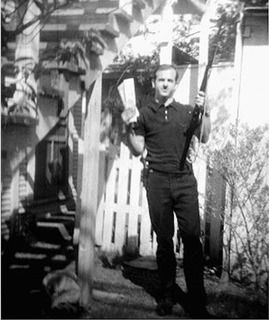
Tom
Tom:
I should be able to do the overlay using the two prepared images above. I can also show a difference map highlighting the pixels which are different in the two pictures. A simple overlay may work better if one or both images is tainted, e.g. yellow/blue. It appears that 133A is sharper than 133B, maybe 133A would be the generic picture, and 133B its clone.
In the meantime, I was also thinking about the possibility that someone took the three picture whilst standing at the same spot and having the camera strap hung over his/her neck which would allow under certain circumstances almost identical views on repeated exposures. Let us explore the issue further, it is worthy.
-
Sandy,
I have been assuming for several years that the Marine with his hand on his hip and the bump on his wrist was Roscoe White. Now I'm beginning to think that I, and many other people, were wrong. Just tonight I realized that the Marine's ears and chin are significantly larger than White's, especially the ears. Look for yourself at the photos in my previous post.
I would like to find photos of Oswald's and White's right wrists, to see if either of them have a bump like the one that's visible in the back yard photo that's the subject of this thread
BTW, I agree with you that "Oswald's" the upper torso looks punier than that of Roscoe "Rock" White. I noticed that some time ago, but didn't want to say anything about it.
My personal feeling is that very few things indeed have already been "established" in this fascinating, but highly-frustrating, case.
-- Tommy

Tommy,
Jack White has further photos of Roscoe White. Yet even the few photos you posted show how different the same person can look over the passage of time. Also -- the Marine photo of Roscoe White that you posted is very blurry, taken with inferior equipment, and so that makes it very difficult to draw a generality about Roscoe's appearance. Notice how thin Roscoe looks in that final Marine mug shot that you posted.
We should get more pictures -- but that lumpy right wrist is no coincidence, IMHO.
Regards,
--Paul
I wonder whether Mr. Jack White left his notes or any other kind of written record of his research. Mr. White was also a member of this forum - is there not any thread in which he would explain details of his research. His research was pioneering, however, a lack of proper written record makes it very complicated for new generation of researchers.
It may be out of context of this thread, however, I think we need a peer reviewed and properly edited JFK assassination journal in which solid pieces of research (such as Mr. Jack White's) would be published in the form or articles. Published articles would either be commented on a forum or receive editor-approved comments which would be also published in the journal. Such JFK journal would not substitute a more spontaneous and creative forum, however, it would ensure that some invaluable data would be properly archived and also quoted.
-
Tom:
Congratulations on your research which illustrates well Jack White's view that the background in the three backyard pictures was identical and only the human figure and its shadows changed.
Your research not only accords Mr. White's conclusion, it also objects findings of HSCA experts which have looked on the background in the backyard pictures and allegedly found no proof of fakery.
http://www.history-matters.com/archive/jfk/hsca/reportvols/vol6/pdf/HSCA_Vol6_4B1_Backyard.pdf
Frankly, there are so many possibilities as to how the backyard pictures were produced that almost any theory is a guess at this stage. I would propose to overlay the backgrounds after rotating, resizing and cropping to identical field of view. I am not sure I myself would be able to do it quickly due to my job duties, however, I hope that someone will.
If your findings of an identical background is confirmed, then we have two options: 1) Marina did not tell that a tripod was used, and/or she never attended this photographic session. A perjury? , or 2) only one picture was taken and that picture (Marina still could have taken it) was used to clone the rest of backyard pictures. If this would be true, I would vote for 133A as the "genuine" one, and the rest to be the clones. What is obvious by viewing the pictures is a very different head/face in 133B compared to 133A - its is difficult to believe that the heads belonged to the same man.
-
Brian:
I never confirmed the reality of the female face which you claim is the only real head in Wiegman's frame 133. I concluded that the face you promote results from 1) low signal and a photographic/digital artifact manifested in the region where "your" female head allegedly occurs, 2) pareidolia as lines and shapes not really originating from a real human face make a visual impression of a head, 3) visual illusion (bistable figure). In none of my messages did I endorse your view. You pointed to a visual phenomenon which Duncan has brought earlier, and you received a feedback from members of this forum. Please count the number of forum members who got convinced by your arguments. You will count zero. Doesn't it tell you that your story is not strong enough?
Notably, the "elongated" head cannot be a "double exposure" or something copied from a GIF. It cannot transpire from a GIF because we have the original frame provided by Chris Davidson, and that frame does show the "elongated" head which all participants of this thread except you agree is the main human figure in frame 133.
Your comments on ROKC and on respected researchers and their work are most inappropriate, in particular because these people are not around and cannot defend themselves. Taking advantage from absence of people whilst negatively commenting on them is cowardice. Your posts reveal that you have a deep problem, an obsession, with the theory of Mr. Murphy which many including myself consider as a major breakthrough in JFK research in the past few years. However, this forum should not provide anyone an outlet for such motivations.
I am afraid that we came to the end of the discussion on this particular figure in frame 133. You have not brought enough clear and unequivocal evidence, and in all fairness you could not - the image in question contains so little information in the critical region that anything occurring there has very limited and conditional value. I would suggest that you refrain from posting on this issue until you gather additional evidence in support of your views. You may have noted that this thread was dormant before your arrival some two weeks ago. The reason is that no one had any new data to discuss, and I find such attitude towards posting correct. Let us post messages that have some original content, are not repetitive, and do not create an impasse.
-
1) No Andrej. Your response makes no effort to acknowledge that you can't concoct your own image using totally different methods and then use it to claim it refutes Davidson. It doesn't. You can't get around the fact it violates your own demand to use original sources. There's no use in repeating the elongated forehead claim because it will prove to not be of merit. Don't you realize that by saying the red outline is a reflection that you dismiss it from consideration as a real face? (and therefore prove why our face is real). You are extremely foolish because Duncan's woman's face is right next to it, so its reflecting an imaginary pareidolia face is very unlikely to the point of impossibility. Imaginary images don't create reflections. Also, a more adept analyzer would realize the fact that you used an alternative tool but still reproduced Duncan's face in the same spot is proof of its veracity. Why? Because you were accusing the woman's face of being an imaginary image created by Davidson's process. The fact you used a different process yet still repeated that same face in the exact same spot proves it is part of the original image and not a pareidolia product of Davidson's Photoshop process. This is an evidentiary checkmate and I thank you for providing it. Your logic requires that the place on the body where a real face should be is occupied not by a real face but by an imaginary one instead. And that a false image created by Davidson's Photoshop process was also repeated exactly by your completely independent separate process.
2) The cause of the double exposure is secondary to its existence and subsequent meaning. The frame by frame breakdown will show it to be a quirk of the gif process and irrelevant to the isolated woman's face that solely exists in the sharp frame. Saying double exposures would be all over the photo is an invalid argument.
3) Nonsense. The film had enough resolution to show the woman's face. Your so-called face was clearly invented from distortion lines created by your photo process that was deliberately designed to offer a less clear image than Davidson's for deceptive purposes. The bottom line is your process is equally distributed throughout your resulting image and unequivocally shows both a disproportionate face as well as one with symmetry. You chose the disproportionate one as accurate and have no excuse for doing so. Your yellow outline shows a face that is worse than "noisy", it is clearly invented out of distortion artifacts. Davidson's clear woman's face from his image shows a face that is what you would see resolve from the available original image with Photoshop contrast improvements applied.
4) Even if true, the obscure oval eye would be Prayer Woman's eye in the double exposure. You can't argue that the much clearer and more visible eyes are those in Duncan's image (including the visible eyeglass frames). Also, there is a visible distortion line passing through eye level in your yellow outline that makes that alleged faint eye obscured and creates a straight unbroken linear artifact across that feature. You are presenting what is clearly a double exposure with a distortion artifact as the main face when the blue outline face does not possess those features and does not possess those features because it is a clear product of the sharp frame and independent of your deliberately obscuring features.
5) You are trying to blame your failures on "noise" (distortion) that doesn't exist. The nose and mouth on the blue outline are much more apparent than your laughable nose and mouth on your imaginary yellow outline face. When called on it you try the wholly dishonest tactic of hiding behind noise when we are talking about clearly visible features. So you call the true nose and mouth, that are plainly visible, noise, and call the real noise the better face. No.
6) It does, for the reasons explained, and will disprove most of what you contend.
7) Foolish. The "sharper" frame IS the original frame. It also differs from the less sharp images you invalidly offer for comparison. You are only proving my point for me. You failed to accurately present Davidson's original sharp frame as it was presented by himself and therefore failed your own demands for original evidence.
Thank you, Brian, for explaining your standpoint again.
-
Brian:
1. I indeed can and actually have to generate my own image of the human figure and the doorway to check whether the one posted by Chris and Duncan was a genuine picture. I find the small image with a green arrow frequently discussed in previous posts as a deliberate presentation of only a part of the image which excluded from view the large "elongated" head. The rest of figure, the "female" face of yours and the reflected one (red head in my post) appear to correspond well in both Duncan's and my versions.
2. We disagree on a double exposure issue. Do you mean the film frame got stuck in the camera for a moment and it was therefore exposed again? Then you would need to see the signs of double exposure all over the picture. Can you?
3. Both the yellow face and blue "face" are very noisy. This area of the picture was almost in complete darkness in the eye of the camera. This is only us who pour light and do all possible effects to make it visible. However, the film has registered too little of information. Therefore, the shapes will be heavily compromised and objects which are symmetric in reality would not be such on a film frame.
4. Please try to view the picture with yellow head on a large and good quality screen (I used a 22 inch HP monitor). One dark circle is where the right eye would be, therefore, I placed a yellow circle there. The left eye is confounded with a horizontal dark line, however, an oval object can anyway be seen on the place where the left eye would be. It is distorted, indeed, which I have emphasised by drawing an ellipse instead of a circle. I doubt you would see these details on a 15.4 inch laptop or smaller.
5. The same as (3). Too much noise to be able to say anything about the shapes and objects there. You see a nose and a mouth which are only a game of your mind.
6. This point does not relate to my work.
7. We do not discuss the "sharper" frame of the GIF anymore. We have the original frame which Chris has used to create the GIF.
-
Brian:
I have not been a part of the button discussion taking place earlier in this thread.
As far as the elongated head is concerned, please note that the image provided by Chris is a screenshot of a video. The video was stopped and a screenshot was made. Thus, there is no double exposure in this process which would trivially explain the presence of the "elongated" head.
I think there is no way to to persuade you or just to seed a grain of doubt into your mind that the the image in question may not be such a great proof of Prayer Woman. It is all right though because people have the right to believe in what they believe even if it may not be the truth.
I have produced a bit brighter and less contrast images from Chris'es frame because this level of brightness allows to view all details of the doorway and figure as they were. If anyone would wish to mix the brightness and contrast to exactly match Chris'es small picture with a face, I would recommend to start by downloading the file using the link which Chris posted yesterday.
Please let me know if I can do anything more in clarifying this unusual problem, however, I think I have already said all what I wanted on the topic of a female face in Wiegman's frame 133.
-
I would like to thank Chris for providing the link to the image which he has used in his animated GIFs, and for giving further details. I did not have access to this particular version of Wiegman's frame 133. I have downloaded the generic image which was used to show the alleged female face and analysed it with a simple tool called Smart Photo Fix in Corel PaintshopProX8. The tool allows to brighten or darken the whole image and to selectively increase or decrease the shadows and the light parts of the picture. The picture below is the crop of the doorway with the original, unprocessed picture in the left panel and the brightness correction added in the right panel. I have not resized the picture. So, now we can view properly the critical part of Wiegman's frame.
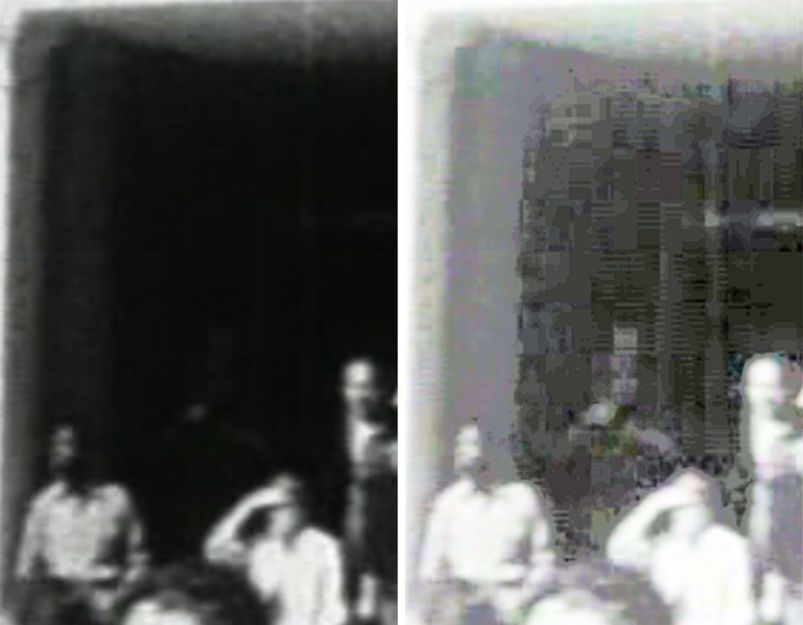
The head area (right panel) clearly shows distortions which may have contributed to the confusion about this head. The next picture shows four panels. The bottom-right one is again the original picture, cropped to see the head and the body and arms with greater details. It is worthy to spend a minute or two just viewing the picture. I can see three heads in this picture, however, only one of them, in my view, is the true one. The head seen by Brian and Duncan is highlighted with blue lines in the top left panel. The head which in my opinion is true Prayer Man's head is highlighted with yellow lines in the top right panel. Please note that the two darker circular spots below the lower contour of the "yellow" head are actually the eyes in the "blue" head. The "Duncan-Brian's" head resulted by borrowing these two darker spots and combining them with the neck of Prayer Man (to create mouth and nose region in blue head) and with the mouth region of Prayer man's (yellow head) head to form the forehead in blue head.
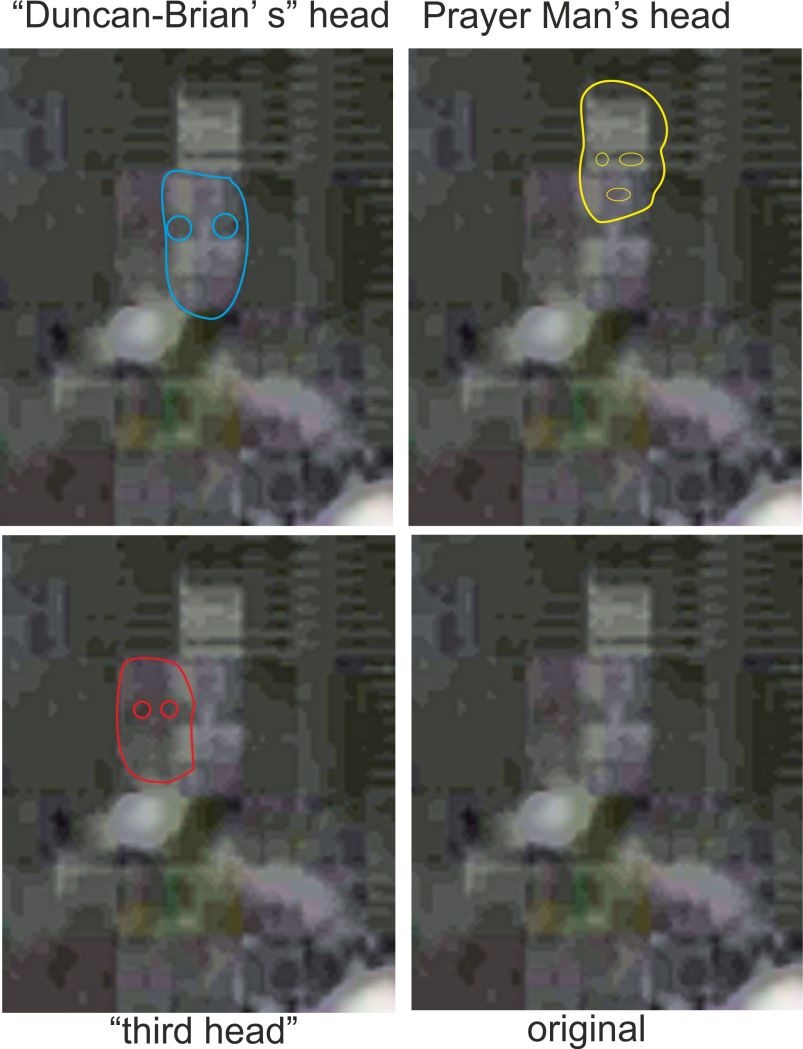
There is also a third head which appears to be a photographic or digital artefact. It is highlighted wiith a red contour in the lower left panel. Since the "blue" and "yellow" heads share parts of the objects (e.g., the "eyes" in blue head), the figure becomes bi-stable. This phenomenon is a well known visual illusion, and can be exemplified with Rubin's (1915) Vase-Face illusion. If you view the picture below for a while, you may note a vase alternating with two female faces.
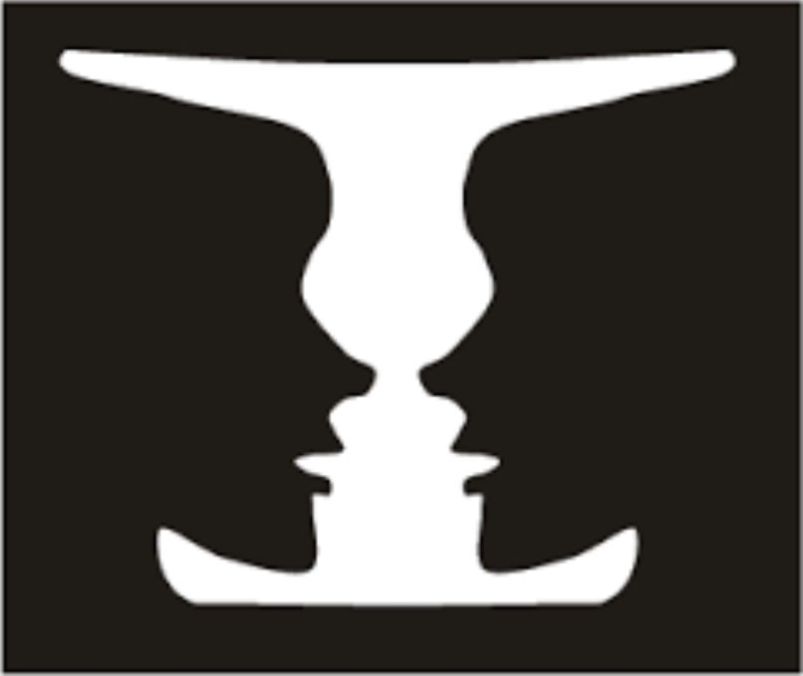
Thanks to Chris'es post, this story, in my view, comes to a resolution. The head which Brian and Duncan considered to be a genuine female head occurs in an area which appears to also show a digital artifact, although the artifact alone was not causing the perception of "Duncan's-Brian's" head. The perception of this face can be compared to pareidolia because here we attribute a sensible interpretation(face) to other shapes which in fact are not the shape we see. However, it may not be exactly pareidolia of the type as when completely random dots make us think that there was a face or a dog in the picture. It rather refers to a visual illusion due to its visual instability (bi-stability). All three factors (1. artifacts and low signal, 2. pareidolia, 3. visual illusion) contributed to the appearance of an object which looks like a human face.
-
https://drive.google.com/file/d/0BwrExtVD005OSnpNZlNjbnpYWXc/view?usp=sharing
The original is from the DVD “Death In Dealy Plaza”
I copied the VOB files directly from the DVD.
Computer = Mac
I viewed the VOB files using this program “MPEG Streamclip” - QuickTime Pro works just as well, with both programs needing “QuickTimeMPEG2.component” for the viewing process.
I snapshot the frame as a PNG.
I can also export as PNG’s but not at 200% which is the size of the linked file.
The screenshot was captured using a gamma of 1.8
The frame is not cropped my me. This is what is supplied on the DVD.
There is no difference in quality (Mac wise) between a snapshot PNG and an exported PNG. (Believe me, I’ve tested this numerous times).
I believe the current frame/s being discussed on the forum were snapshot at 100%.
The photoshop process for this frame would have been the same as the others, although I believe I also used a "Topaz Labs plugin" contrast filter to try and bring out more detail in the shadows. There are dozens to choose from.
Bart Kamp did a good job in his collage trying to match whatever I had previously produced. He marked it "Hairline and Ear". Maybe he remembers his exact method for contrast adjustments, I don't.
As far as I could find, this was the closest I could get (generation wise) to some type of documented version.
What generation is it? I don't know.
The 16mm Wiegman film, more than likely, was supplied by the 6th Floor Museum for the T.V. show.
The rest is up to those still interested.
Good Luck,
chris
Thanks, Chris, this is very useful. I did not have access to the picture you started with.
-
Dear Brian:
I would like to apologise for my unfair and completely inappropriate reference to your health, and am glad that you carry on the discussion in spite of this insult. I will delete the rest of my criticism if I see that you are willing to discuss the matters in a technical and objective way, for now I remain cautious. Your last post gives me some hope that a reasonable discussion is possible, and therefore, I resume. I would prefer if you call me Andrej instead Mr Stancak. We fight fiercely on this forum, however, it is still a friendly bunch of people here.
I wonder if you would help me to locate the source image from which the woman face/figure has been obtained. The picture which you refer as the source image and actually the ultimate result is not the original Wiegman's frame (still, photograph). The reason for me wanting to see the large, untouched still is that I want to go the way you describe and reach or not the same result as Chris Davidson or Duncan have reported. I also have concerns about the space above the figure's head which would allow to say if the picture is a real and complete head or only some wishful selection. I realise that you may not be that skilled in computer graphics which is fully ok, and therefore, just please let me know if one of the following two frames would be the one showing the figure of your interest:
Could it be this frame?
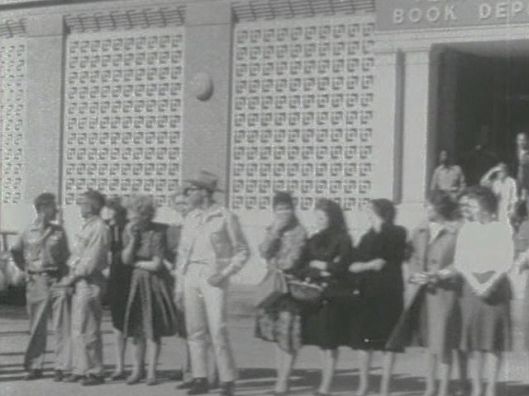
Or would it rather be this frame?
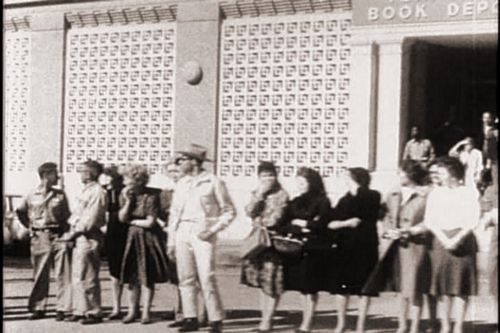
If neither of these two pictures would be the ones which yielded the picture you promote, would you please either post or link the correct frame. We avoid the GIFs frames as they already have been extensively processed.
The reason for asking for this frame is that extensive processing or selective cropping may sometimes produce unexpected results, mostly various shapes. For instance, a simple step such as resizing can be quite aggressive and change the contours of objects. If a resampled image is then subject to brightness/contrast or other operation, it may suddenly start to show weird things. I am not saying that this happend in the case of the photograph in question, however, it is necessary to see the original picture without any lines crossing the face and without a corona highlighting the figure. The reason for posting two dark frames in my previous post was that these were unprocessed images, therefore, they contained original information not altered by my processing. These images need to be viewed for few minutes in a dark room to appreciate what the picture tells you.
I will come to the possibility of pareidolia later after it will be clear how the picture you are interested in was produced.
-
Brian:
[Removed}
It is obvious that you know that Duncan's picture contains a wishful suppression of the other head just above the one you claim, and you are not even ashamed. You know that no expert has ever confirmed or will confirm anything you wrote about this picture. You ignore any request to present original data. You do not understand that other researchers have full right to ask for the original picture you or your collaborators used. You place yourself as the one who decides what evidence is the best, however, you have not demonstrated your expertise in anything. You do not understand that the purpose of the forum is to mutually check results else it is very easy to commit a mistake. You only refer to the work of other people who themselves do not defend the case because they know they would come short. You yourself have not produced a single result, you only criticise the work of other researchers. You have no intention to collaborate. You think that only your view is correct, but this best view cannot be verified. It therefore can be discussed ad nauseam without any resolution. Who do you think will play this game with you? You had your chance but you have forfeited.
I hope that the administrator this time not only delete your messages but your entire profile. Until then I am withdrawing from posting on EF as I would feel embarrassed to be in your company.
-
Mr Stancak is once again in defiance of science and refuses to directly address what I am writing. If you'll notice he does not address any of the points I made showing why the woman's face in MacRae's enlargement can't be pareidolia.
Mr Stancak also enters 3 dark images where almost nothing is visible in terms of Prayer Woman. This is not sound analysis because it does not offer the readers the best evidence. I feel it makes an attempt to cloud the good evidence by suggesting qualities of darkness that unconsciously imply lack of visibility or visible evidence. Mr Stancak's images are useless towards this debate and only serve as background to a specious rumination on pareidolia that is being offered as a parallel argument instead of directly confronting my points.
Those points were:
1) That a clearly defined face, that exists exactly on the body where a face would be, as exists in Duncan's image, is one that is vastly more likely to be a real face than an imaginary one. Mr Stancak offers no reply to this.
2) Photo experts could examine both Davidson's Photoshop methodology and the resulting image and confirm whether or not the face derived from a clean photo process. This is a rather apparent elephant in the room that I feel Mr Stancak does not confront, nor does he offer the best arguments or approach by not doing so.
3) I don't think Mr Stancak realizes we are through the looking glass on this and those same experts could examine the image with the woman's face on a micro photo tech basis and see that the subtle photo properties of that face matches other real objects that were similarly brought out by Davidson's process.
4) Mr Stancak totally ignores that the facial posture of that face matches other known activities seen in the same animated gif. When Davidson's gif is run it shows a woman holding her purse with both hands up by her face. The face itself is obviously looking down into that purse being held up to it. This is a corroborating behavioral forensic dynamic that makes the suggestion the woman's face had all these confirming forensic factors by pure chance, and was an imaginary image that just so happened to do all these things, in the impossible range.
5) The specific facial features are anatomically precise, which is unlikely in pareidolia images. (Also ignored)
6) There's a clearly visible pair of woman's style eyeglass rims on Prayer Woman's visible glasses. This will also be confirmed by expert photo analysts. (Also ignored)
7) This entire debate is silly because once the best photo experts got hold of the Wiegman Film and applied the best modern technology to it they would confirm everything I've written and end the issue. The Prayer Man claim is doomed by science.
Sorry, but you can't ignore this condemning scientific proof and just offer another discussion of pareidolia. Nowhere in Mr Stancak's reply is there any attempt to explain why Davidson's Photoshop technique wasn't valid or why the more than obvious image of a woman's face wasn't the clean result of that valid process.
Brian:
I have presented two darker images and one bright image, so you cannot say that you do not see it. You see the content of the bright picture well. Please note one extra face located below the top margin in the left corner of the last picture in my previous post. This is a problem, isn't it: there are faces at improbable locations in the noisy parts of the old picture. Naturally, Duncan has cut off anything above your female head - the true Prayer Man and also the one illusory face shown in my previous post.
You write "Photo experts could examine both Davidson's Photoshop methodology and the resulting image and confirm whether or not the face derived from a clean photo process."
Brian, please, bring on the experts. You write they would confirm all what you claim, however, no one has yet. We want to see the experts's statements. We also want to see the whole process of your (Duncan's) analysis: what generic Wiegman's picture you took (a link), what part of the doorway you cut, which tools and in which order and intensity have you used. One of the basic principles of any research work is the reproducibility: we need to able to replicate the path Duncan or whoever went to produce exactly this image. If not, the final product can be an error or even worse, a fabrication. Therefore, I ask you again to provide the details allowing us to evaluate what methods were used.
"Once the best photo experts got hold of the Wiegman Film and applied the best modern technology to it they would confirm everything I've written and end the issue".
Ok, Brian, when will it be? Why haven't you already asked the best photo experts to analyse the picture (but which picture - we still do not know what was the generic picture).
"Nowhere in Mr Stancak's reply is there any attempt to explain why Davidson's Photoshop technique wasn't valid or why the more than obvious image of a woman's face wasn't the clean result of that valid process."
Brian, please post or link the original Wiegman's frame from which your alleged female has been produced, and please give us details about the methods. If you give us these details, I will be able to comment on the validity of Duncan's picture. We need to know in particular what was the original Wiegman's still (there are multiple version of it), what resolution it had and whether it was resized and using which algorithm, what section of the doorway has been cut and why, in particular why the space above the alleged head was not analysed, what tools (brightness: what intensity, contrast: what ratio, any other tool?)
"There's a clearly visible pair of woman's style eyeglass rims on Prayer Woman's visible glasses. This will also be confirmed by expert photo analysts. (Also ignored)"
Ok, Brian: the eyeglass rims are only your subjective impressions, aren't they?. Why then you propose it as a fact? When will it be confirmed by expert photo analysts? I am pretty sure that a photographic experts would try to politely explain that this dark area of the doorway cannot show you details you claim to see (eyeglasses, fingers in your other post). Even if you "see" them, other people would not see them like you do - you therefore assume they are either 1) dumb, 2) ill minded towards your theory, 3) or both. Well, this type of reasoning belongs to the Louisiana State Mental Hospital, Jackson, not to the EF.
-
The face which Brian and Duncan have seen in one of the GIF images is, in my opinion, a pareidolia – the game of our mind which connects uncertain, noisy elements of visual field into a face. As I mentioned in my previous post about the experiment by Glasgow scientists, two circles with a dash in between is enough for people to falsely claim that there was a face in a cloud of noisy dots.
To evaluate the GIF in which alleged female face is present, one needs to evaluate how much information is present in the original image. If the information is low, the risk of pareidolia is high as the elements in the picture were most likely random assemblies of pixels. Therefore, I requested in several posts that the original large frame from which any analysis has been made would be provided. The best version of Wiegman frame 133 which I was able to locate is the one below. The picture was downloaded from the excellent ROKC repository of photographs. The picture is bright enough as it stands to be analysed without any further processing.
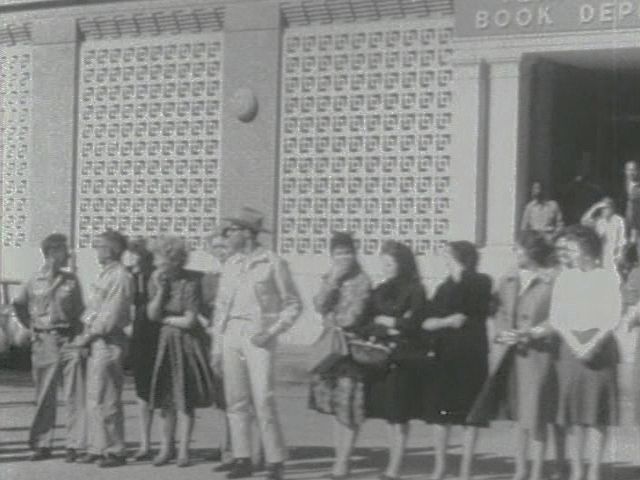
I have cut the part of the doorway containing Prayer Man without adding any processing. The picture, in my view, shows the male head and also a relatively bright neck and part of the chest. There is a dark spot next to Prayer Man’s right side of his neck, which relates to the dark background. The left side of the neck also shows a slightly darker area (which can be made even darker by adding brightness/contrast). Below these two darker spots next to the left and right side of the neck, there are slightly brighter regions corresponding to Prayer Man’s neck and/or chest (white T-shirt).
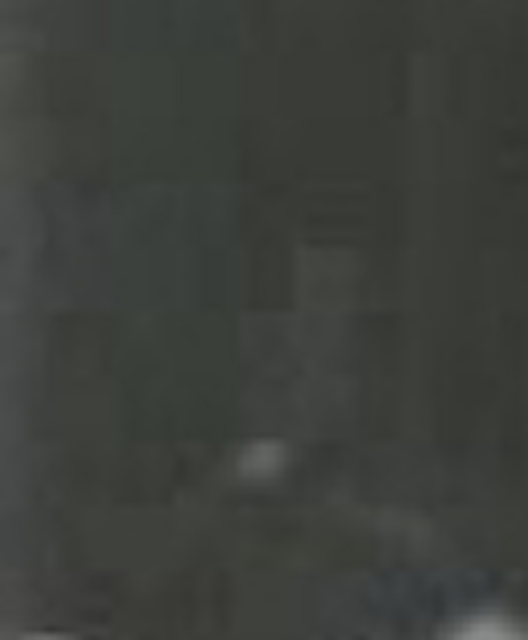
Now, this picture is bistable. If you look at it for some time, you either see the Prayer Man’s head, or you rather see another head in Prayer Man's neck area. This illusory head is created by two darker spots next to Prayer Man’s neck, the border of the white T-shirt (or skin of the chest) and Prayer Man’s chin standing for the forehead of this illusion head.
There is also a problem of image quality which contributes to the pareidolic capacity of this picture. Although the original Wiegman's still looks great, once we start to analyse it on pixel level, it becomes clear that it has been created in a digital process which involves data compression, something what Chris Newton has emphasised recently. The digital artifacts often manifest as larger squares of pixels which are displaced ususally by one row of pixels from neighboring squares of pixels. It is likely that that this displacement of pixel assemblies also occurred in the area of Prayer Man’ face. Below is a corrected image in which the whole square of pixels has been moved one row of pixels to the right. The continuity of the lines in Prayer Man’s head becomes natural and obvious.
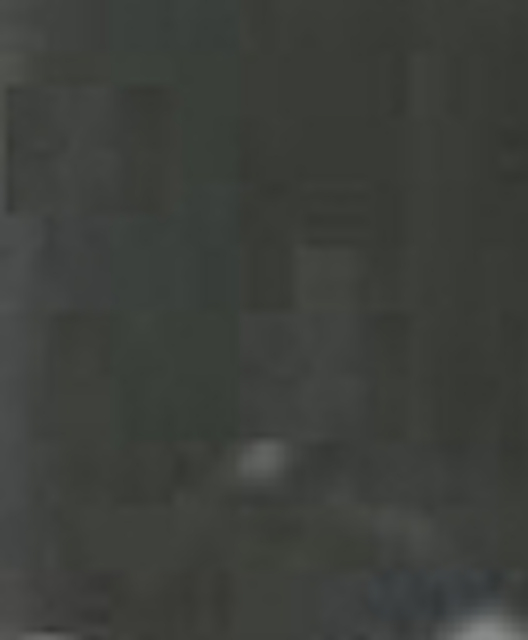
With a bit of reasoning we can discard the lower face as a real human face. If the lower face would be the true one, where would the upper head come from? In contrast, if we accept the top head as the true one, the lower head can be explained as an illusion or pareidolia.
I am adding one more, processed, picture for those who would not be able to view the above two pictures in a dark room (there is not much seen if ambient light is strong). I have added the contrast and the light.
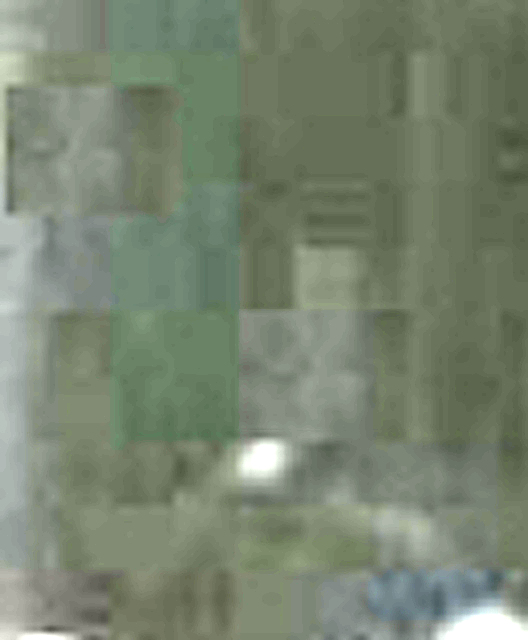
The power of pareidolia can be appreciated if you view the upper left corner of this image - there is one more head looking to the right.
-
Brian:
if you know which Wiegman's frame it is which shows the female head, why don't you show us how it is possible to identify a female face in it. You comment on the work of other people but you yourself fail to demonstrate anything. Please, identify the original picture which you think yielded the female face, and show all intermediate steps, and the result. If not, this silly game of yours will continue on and on. We were nice to you, however, this is about the end of it.
Well, we can stop responding to your posts, however, in that case you would be allowed to effectively steal and destroy this thread. If you fail to provide any photographic evidence to support your claims in your next post, I will contact the Administrator to consult possible solutions. I cannot see that the Administrator would see any advantage in serious researchers leaving the EF.
-
Andrej
What you are pointing out is what I've been saying all along, that the extant video we have to work with is of such poor quality that determining what is in that corner with any certainty is nearly impossible.
I could really bore a lot of folks with everything that can be done to a video to screw up the encoding process but let me simply point out to everyone that uploading a video to youtube means that the original video on the computer pre-upload is one generation cleaner than whatever you put on youtube. Every time it's re-encoded detail is destroyed.
The "data' that video encoders generally toss first is the "data" we are trying to analyze namely in the shadows and dark areas.
Thanks, Chris, for reminding us the unfortunate issue of using youtube videos for photographic analysis. The Wiegman's still I used is not from a video though. I only used video to find out what frame number it was. This still is of much better quality than a youtube video of Robert Groden's copy of Wiegman film.
-
[...]
Wiegman's film, Frame 133

I have cut the region which Chris analysed in detail (below). The left panel shows the original picture. The middle panel is the same picture with only brightness added. This at least allowed to indicate the top of this person's head, which is highlighted by horizontal blue lines interspersed between pictures. The right panel is the one which should be the closest to Chris'es picture - both brightness and the contrast have been added. While the "Oswaldian" forehead is visible, the rest of head and the neck create another head. However, this is just an artifact caused by forcing the image to show at least something.
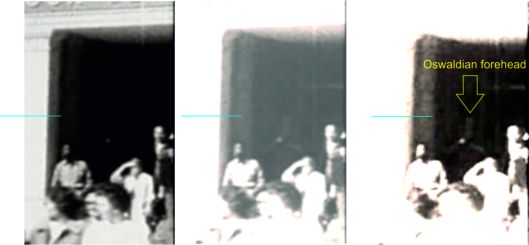
[...]
Andrej,
I don't think that's a "double forehead." I think
OswaldPrayer Man has raised his head up and we also see his white T-shirt under his darker-colored outer shirt.-- Tommy

Thomas:
the signal in this particular area does not warrant any statement about whether it was a female or other head, or whether it was a T-shirt combined with outer shirt. Please have a look on the original Wiegman's frame. If you struggle to spot a human figure there, there is no chance to identify any details. It is likely that it was the brightness of the neck or T-shirt fusing with the head, however, this is already our speculation.
-
I was able to identify the Wiegman's film frame which Chris Davidson has used in his analysis. It is frame 133 in the series of frames in Robert Groden's copy. I was able to locate it on internet and post is here. Please note that the part of doorway is in complete darkness. It is dark because there is almost no signal (information) there. We only see the bright spot suggesting that someone stood there. If the signal is that poor, any statement about the sharpness of any objects in this area of picture has no merit. One cannot have a sharp image of a face if neither the head or the body can be seen.
Wiegman's film, Frame 133

I have cut the region which Chris analysed in detail (below). The left panel shows the original picture. The middle panel is the same picture with only brightness added. This at least allowed to indicate the top of this person's head, which is highlighted by horizontal blue lines interspersed between pictures. The right panel is the one which should be the closest to Chris'es picture - both brightness and the contrast have been added. While the "Oswaldian" forehead is visible, the rest of head and the neck create another head. However, this is just an artefact caused by forcing the image to show at least something.

There has been a clever experiment performed by experimental psychologists in Glasgow. They generated random arrays of dots and asked their participants to press a key once they think there was a human face buried in the cloud of dots. They presented hundreds of such pictures, and then averaged the small percentage of pictures which people claimed to contain a human face (there never was any face in any of the pictures - dots were all random). The averaged image surprisingly showed two small circles as if eyes and a small dash line between and slightly below the eyes as if it would be the nose. When people believed that there was a human face in the cloud of random dots, their fusiform gyrus in temporo-occipital cortex (this is where human faces are interpreted in the brain) was activated. Human face is a powerful pareidolia object, and it is not surprising - from infancy we are primed and keen to see human faces. Thus, it is not that difficult to view a human face even if the visual field does not contain any face.
Taken together, this image and its processed products cannot prove the identity of Prayer Man. The part corresponding to head and neck contained as if two heads, the lower of the two not having any neck.
We may agree that: 1) there was someone standing in that part of the doorway, 2) the person held a bright object in his right hand, 3) we may draw a line defining the top of this person's head, 4) we can assume that the arms are in a similar "prayer" gesture as we see in Darnell. 5) there is a continuity between the person we see in Wiegman's and Darnell's films. Thus, identity information derived from Darnell's stills will apply to Wiegman's film. Due to the noise and poor signal in Wiegman's still, this inference does not hold vice versa.
-
Brian:
it is not my obligation to provide evidence on your behalf. You may wish to contact the Author and ask him kindly to re-post his results. I am willing to look at any evidence once you show any.
-
Brian:
we need to see your evidence to be able to comment. Please provide an article, link, or a post number describing the "evidence" so that we can have a look again if you wish so.
I would be grateful if you could keep your messages less personal else what will hapen is that people will start ignoring you not because of their alleged inability to discuss specific points but simply because they do not like your too personal style.
-
Brian:
would you please indicate Chris'es post in which in your view he proved that Prayer Man was actually a woman. I am familiar with this thread but in none of the posts did Chris prove anything, and as I know the style of his work and posting, he would not even pretend doing so. Chris might have had an opinion, as we all have.
-
Brian:
Maybe I need to point to the problem of using Wiegman's film in clarification of Prayer Man's identity more clearly. The top panel shows a very nice frame of Wiegman's film, downloaded from ROKC picture repository (http://www.reopenkennedycase.org/apps/photos/photo?photoid=199187640). One would not even think that there is Prayer Man in that very dark corner. This part of the doorway was covered by a shadow and the Wiegman's camera and film produced too much contrast and, together with the distance of shooting, did not yield enough signal there. The lower panel shows the effect of Fill light and clarity tool (Corel Painshop Pro). Indeed, adding light has helped to identify a human figure and his gesture and a light object about at the level of the mouth, however, this is about all what we can say about this figure. Once this noisy image is processed further (magnifying, resampling etc.), it starts to create chunks which have no good interprepation. There is simply not enough information there.
If you would like to make the case for a female using Wiegman's film, would you please provide the original Wiegman's frame from which results have been produced, and demonstrate every processing step.
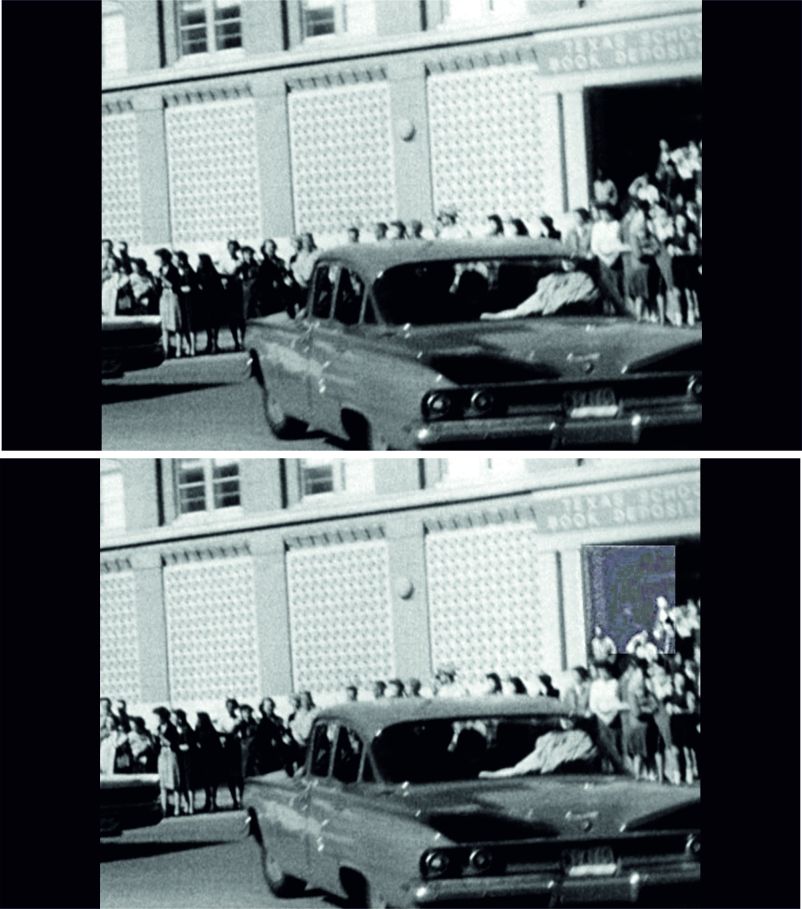
-
Brian:
Unfortunately, the signal in the dark corner of the doorway in Wiegman's film is just too poor for an unequivocal indentification of the person which others and I believe is a man. The figure's head appears to be split into two causing it to appear too tall in some frames. Unless there is a better copy of Wiegman's film we may not be able to identify beyond any doubts the person's identity solely from Wiegman's film. I have contacted the Sixth Floor Museum in January 2015, and they were kind enough to communicate the recommendation of the late Gary Mack that Oliver Stone has used a copy of Wiegman which was in the film archive of UCLA, LA (a 35 mm copy). "Four days in November" film was their next recommendation. All other sources appear to rely on the original NBC footage from 11/22/63. I have contacted NBC right away after the email exchange with SFM, however, they never replied to my query.
This leaves Darnell's film as a much better candidate for any feature analysis and maybe identification. The problem is well known as a face recognition problem, and it has been intensively studied over past years. Thanks to the advance of face recognition algorithms, we can have electronic passports etc. However, the algorithms suffer if the face image is noisy, does not show enough of facial features, and - importantly - the face cannot be viewed from a direct front view. I have posted few ideas how to deal with this problem in one of my previous posts in this thread.
I have analysed the height of Prayer Man in detail, also in this thread. However, even without a 3D reconstruction and just by applying some logical thinking one can get that Prayer Man in Darnel's film cannot be someone too small. The top of Prayer Man's head aligns with the neck/shoulder line of Wesley Buell Frazier and since the height of human head is 9''.4 on average, the height of Prayer Man, if we assume he was standing on the top landing, would be only between 5'1'' and 5'3'' (Frazier's body height was 6'). However, a small person has also shorter arms and narrower shoulders which causes impossibility to align his/her arms and body exactly in Prayer Man's style - the arms of that small person would be too short. Naturally, one can distort the arms of a small person to somehow fit Prayer Man's arms, howoever, the distance between the head (e.g., chin) and the arms would then be too short and unlike we see in Prayer Man.
Mr. Murphy's research showed logical problems in the testimonies of a number of witnesses pointing to fabrication of second floor encounter. Prayer Man's figure in Darnell would miss the point without this logical analysis of the second floor encounter. Second floor encounter is currently discussed by experts in another thread in this forum in case you would be interested.
-
Sandy:
I found a better version of Figure RIT 4.1 in the HSCA report, page 182. It shows that the bottom two squares did really stand out from the brick wall and therefore, cannot be used for any pincushion analysis. Naturally, a small pincushion effect is present also in the picture below, however, it is not that strong as indicated with your blue lines which wrongly copy the bottom rectangles. In contrast to the bottom squares, which appear to be framed, the top square is mounted flat and fixated in the corners with pieces of tape. This square reveals an optical problem of this particular camera which appears to have been overlooked for so many years. As I am constructing the 3D model of the doorway, I can now trust rather my model in terms of the vertical lines than the pictures from this camera - the program does not know about any imperfections of this particular Imperial camera.
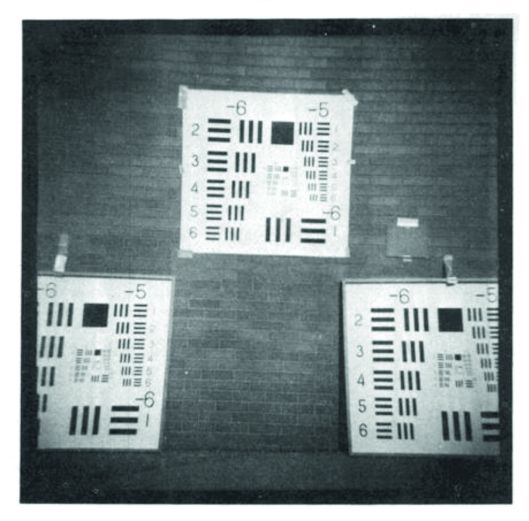
This picture is very useful. It shows that the vertical lines in the bottom part, especially in the centre of the picture, were straight. The problem is the right upper quadrant, especially the part which is occupied by the right top part of the square. It causes the vertical line to fall rightwards, and maybe the horizontal lines downwards.
To convince you that Oswald's camera distorted the pictures especially in the upper right quadrant, I am posting a family picture made by Lee Oswald. There are no guiding lines here, however, I hope you can extend the edges of the top square into the family picture (I have aligned the left edge of the top square with the brick column in the upper picture). The brick column is straight, however, the windows grills further to the right and the right wall fall towards the right. Please, note the leftward orientation of the window in the left part of the family picture, exactly as in CE133A.
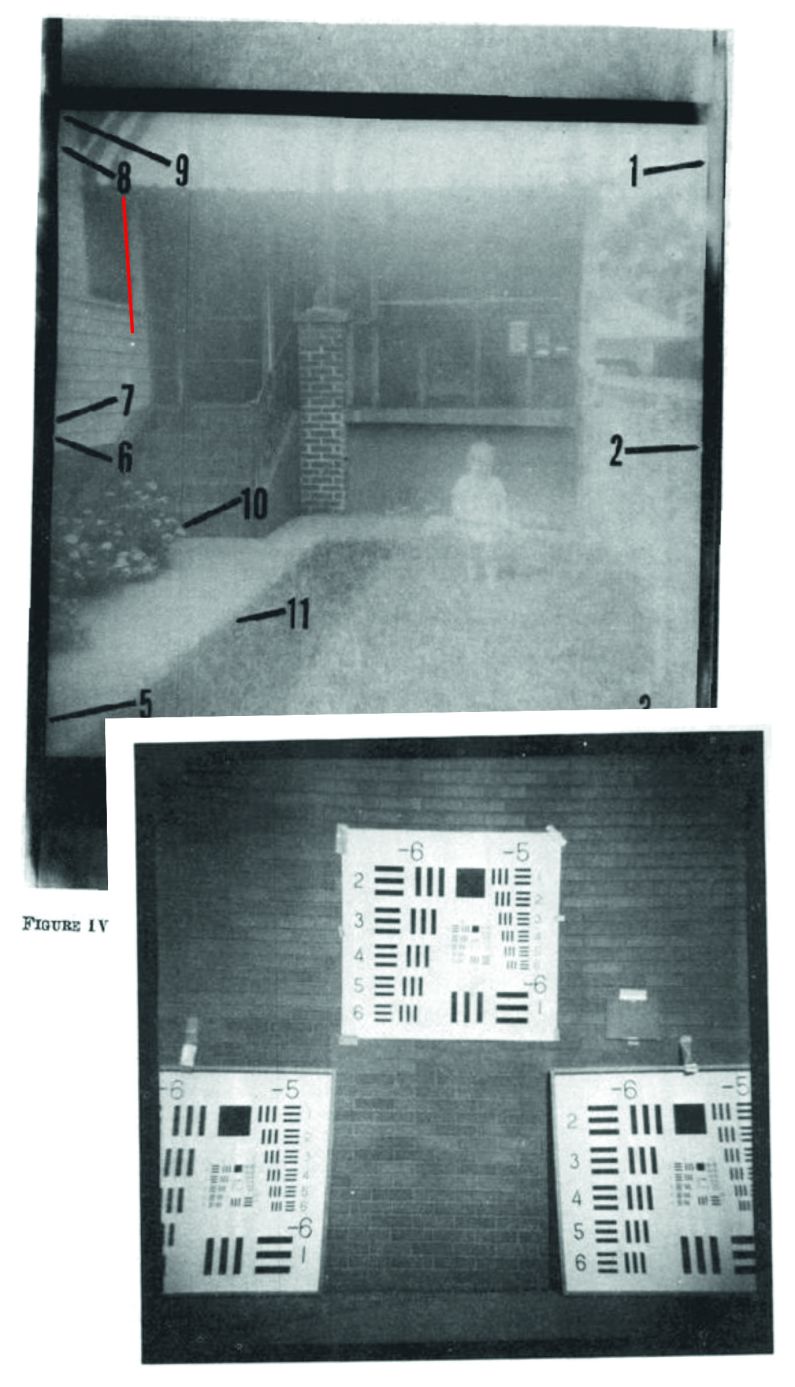
I hope I have answered your queries. I am posting below the updated alignements of RIT 4.1. and the three backyard pictures.
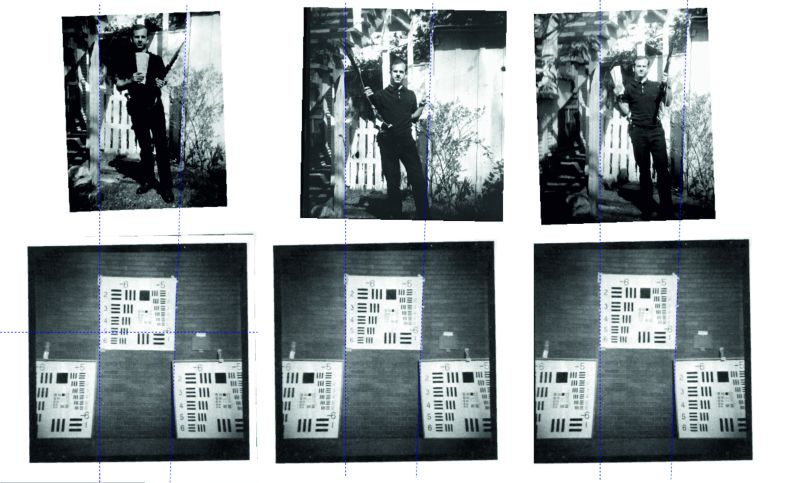
That's a good find Andrej.
I see now that we're not dealing with a posterboard, but rather with a large wall. And the "curled papers" are really large posters that are set on the floor and leaning against the wall. As you remarked, this is a problem for pincushion analysis because the leaning posters introduce a large amount of perspective distortion. It is difficult to distinguish between the perspective distortion and the pincushion distortion. What this means is that I can't draw vertical lines at the bottom showing that the vertical lines in the BYPs must also diverge like they do at the top if you accept that the optical distortions in this photo represents the distortions in the BYPs.
In short, there is nothing I can do with this photo.
However, as it turns out that's a moot point. Because after studying carefully the family photo you presented, I became convinced that asymmetrical distortion was occurring. It's not supposed to occur given the symmetrical way lens elements are manufactured. But when I saw in the home photo all kinds of asymmetrical distortions (for example pincushioning on the right outside wall and roof-line, but straight angles in other areas) I concluded that significant asymmetrical distortions were indeed occurring.
I checked further and discovered that the lens for this camera is made out of plastic. BINGO! I knew I had found the problem.
Glass lenses are ground and polished in a way that maintains symmetry. Plastic lenses, I'm sure, are not ground at all. They are made by casting or injection molding. The shape is determined by the mold, which was made in some machine shop. Machine shops don't necessarily use cutting techniques designed to make a mold radially symmetrical.
So, as of now I believe that the angles we see in the BYPs are due to imperfections in the plastic lens. Not keystoning. I could change my mind if a photo from the same camera surfaces that doesn't have the same optical foot print as the other photos. But right now I'm satisfied with this conclusion.
Sandy:
thanks for summarising the issue. Your posts on lens distortions and other photographic problems were very educative. I am glad we found agreement in the problem of divergent vertical lines. Let us see where this thread will lead us further.
-
Paul:
my interest is actually the posture of Prayer Man as this is the problem I have been working on for a long time, and I somehow occurred in this thread. According to what you write, my future here seems to be pretty grim.
Well, then I misunderstood, somehow, Andrej. I thought the main question of everybody here was whether or not the BYP were authentic. I thought you were arguing for the BYP being authentic. I was seeking feedback on Roscoe White's chin in the BYP.
If I've misunderstood you, Andrej, then I apologize.
Regards,
--Paul
Paul:
I am afraid that you have misunderstood. Please read the title of the thread:
How Did They Get Roscoe White To Lean Like That And Not Fall Over?The question of authenticity of the backyard picture came later, however, no harm done.


How Did They Get Roscoe White To Lean Like That And Not Fall Over?
in JFK Assassination Debate
Posted · Edited by Andrej Stancak
Well, here is slide 114 from Jack White's collection. Thanks to Sandy for posting the link in another thread. So, after all Mr. White did leave his most important images and results in a database. The slide 114 from Mr. White's collection is a game changer: (please see my EDIT and CORRECTION below)
This backyard picture was taken at the same time as the rest of pictures and stands in perfect alignment with CE133A. Please find below overlays of slide 114 (plain background) with CE133 with 30%, 50% and 70% blending of CE133A.
At 30%:
At 50%:
At 70%:
All lines and details are in perfect alignment in the plain backyard picture and in CE133. This can only be achieved using a tripod, no doubts in my mind.
If Mr. White had the plain backyard picture at his disposal, it was quite straightforward to figure out that composite pictures were made.
One cannot take two pictures at different instants (after turning the knob which turns the film to a new field) from a hand held camera with this perfect alignment. A tripod was used. Marina did not speak the truth about the backyard pictures since she has claimed to manipulate the camera.
Importantly, the existence of such a crucial picture as the picture of backyard with no person in it was not mentioned either by Warren Commission or the HSCA. The commissioners and experts realised that this picture would expose this fraud and Oswald's framing.
-------------------------------------------------------------------------------------------------------------------------------------------------------------------------------------------------------------------------------------------------------------------
EDIT and CORRECTION: my enthusiasm for the picture with no person in it has evaporated after Tom posted a message by Craig Lamson. Craig explains that the picture in slide 114 has been digitally prepared for Oliver Stone film by removing man's figure from one of backyard photographs. So, please do not let be misled by the obvious correspondence of slide 114 and CE133A as I did. There is nothing wrong to overlay the two pictures, however, the implications were wrong.